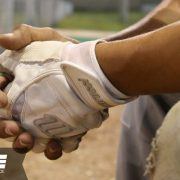4 Lifestyle Factors That Affect Baseball Performance
As the summertime rolls around, the baseball tournament season is beginning to get heavy. Schedules begin to fluctuate between morning double headers and long travel for tournament play.
Hopefully, your body isn’t worn down because you’re in a solid strength and conditioning program. It’s important to maintain your athletic qualities so that they enhance your athletic skills on the field.
However, what a lot of players forget to even think about is a bunch of lifestyle factors that ultimately affect their performance. These factors can be both negative or positive. I often like to highlight 4 specific lifestyle factors that you’re not considering. These include sleep, nutrition, stress, and soreness.
Positive Factors: Sleep and Nutrition
Sleep may be the most important of the positive factors. This becomes critical when schedules are hectic. If you aren’t well rested, this will negatively affect your performance.
When my athletes log how many hours of sleep they get, I usually take off an hour. This is because we aren’t in a “deep sleep” for those “x” number of hours.
What if you have an early 8:30am game, and need to be at the field an hour before? When should you realistically wake up?
Does it take a while for you to “wake up”? Do you usually feel exhausted?
Does it take a while for you to “warm up” and stretch out as soon as you’re out of bed stiff as a rock?
These are all questions the athlete must think about.
Sleep, the hopeful 8-hour window, is when recovery takes place. It is during this time where growth hormone peaks, and testosterone usually peaks as soon as you wake up in the morning.
In my eBook, “The Game Day Guide to Optimal Baseball Performance”, I talk about how you can develop a nightly routine so that you can wake up feeling refreshed and ready to go on a steady basis.
When it comes to nutrition, this positive factor should also be ranked above a “7”.
Realistically, it will never be a “10” or a “9”. When ranking yourself daily, it’s important not to cheat! Be real with yourself!
Do you usually skip breakfast?
Did you eat any sort of fast-food prior to sleeping?
Do you drink enough water throughout the day?
Do you have enough pre-game snacks stored with you?
Again, these are all questions the athlete must think about.
Here’s a sample of a quality pre-game snack that includes protein, quality carbs, and healthy fats
- Protein shake, apple and banana, trail mix with some sort of nuts and raisins
- Banana and almond butter, hard-boiled egg, oranges/clementine’s
- Greek yogurt with raw nuts, chicken/fish
When it comes to timing for nutrition, this becomes highly individual. For some, eating 30 minutes before warming up for a game might be the best option.
On the other hand, I know a handful of athletes that would rather eat an hour before a game because they like to play “hungry” and “fueled”.
Negative Factors: Stress and Soreness
The body does not know the difference between the stress before a game, during the game, after the game, or in the weight room. Stress is stress. This is important to consider because too much stress on the body can negative affect performance.
Therefore, these negative factors should be ranked below a 3 on the 1-10 scale as previously mentioned.
I use a pitch grid for my pitchers not only to track pitch count, but to track stress and soreness throughout the entire game. This will dictate how far/how much they throw in the following days from a start.
For position players, tracking your stress, or just being cognizant of it, is just as important because you’re getting more time on the field than the pitchers.
Did you get a lift in before the game? A day before the game? Two days before the game?
Not to get too specific with strength and conditioning, but if you do too much before a game this will peak the stress levels in your body.
One thing that worked for me in my playing career if I felt stressed before a game was to use mental imagery before the game. Imagine yourself playing from a first-person view and a third-person view.
See yourself performing at high levels, trusting your abilities, acting confident, breathing, and committing to every single play!
Tracking stress along with soreness gives a better picture of accumulated fatigue in baseball players.
Is your arm hanging from your shoulder? Is your back super sore and achy from all the swings you take?
If you’re not feeling too hot when you arrive at the field, make sure you do an extended warm up on your own on top of your team warmup.
How to Calculate Your Readiness Scores
When tracking these 4 lifestyle factors, baseball players can be even more aware of what they need to do to become game ready. When we put these 4 factors together, we can compute a readiness score.
When you try to determine their impact on your performance, I often recommend that you use a scale from 0-10 to form your readiness score.
On a scale from 1-10, positive factors should be ranked high, ideally a 7 or above.
On the other hand, negative factors should be ranked low, ideally a 3 or below.
To create a readiness score, just add your positive factors together and your negative factors together. Then, subtract your negative factors from your positive factors.
Here’s what a typical readiness score would look like:
- Sleep – Quality 8 hours of sleep but tossed and turned a little in the AM, so 9/10
- Nutrition – Had a good meal earlier in the day but had fast food at night, so 5/10
- Stress – Had a good day with minimal stress, so 1/10
- Soreness – Minimal soreness from the past day, so 2/10
You would then add those up:
- Positive scores 9 + 5 = 14
- Negative scores 1 + 2 = 3
- Positive scores 14 – negative scores 3 = 11 readiness score
If you have a high readiness score, realistically a 14 or above, expect a high-performance day!
If you have a low readiness score, realistically a 10 or below, don’t expect to be performing at high levels.
So based on the example above, You’re in the middle. It’s easy to see how you can improve your readiness for tomorrow based on this.
If we track these factors daily, we can see fluctuations in our readiness scores and our performance. This makes the light bulb turn on in players because it makes it easy to link your performance to these factors. You may make better decisions with your nutrition intake, or get a little extra sleep when the day was more stressful.
The Game Day Guide to Optimal Baseball Performance
To review more concepts like this, check out my new eBook, The Game Day Guide to Optimal Baseball Performance.
In the Game Day Guide, I go over everything from what you should be focusing on in the offseason to research driven techniques to enhance your game day performance, and everything in between!
With 80+ pages of content and more than 15 cited research articles, I give an unbiased opinion on what you could do to become a better baseball player. I lay out the facts, but it is up to you the player, or coach, to decide how this information can be applied today!
Jarad Vollkommer
Latest posts by Jarad Vollkommer (see all)
- Strength-Speed: Customized Mechanics for Baseball Pitchers - August 20, 2019
- Determining Individual Stability Needs for the Baseball Player - June 25, 2019
- In-Season Training Metrics for the Baseball Player - March 5, 2019








Leave a Reply
Want to join the discussion?Feel free to contribute!